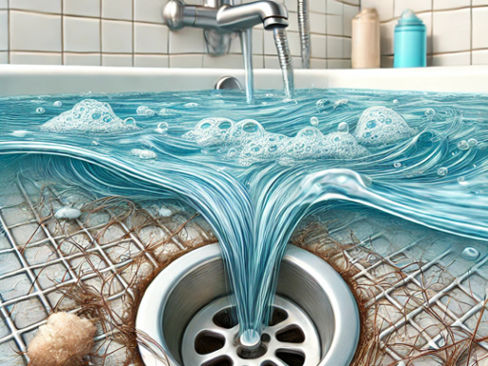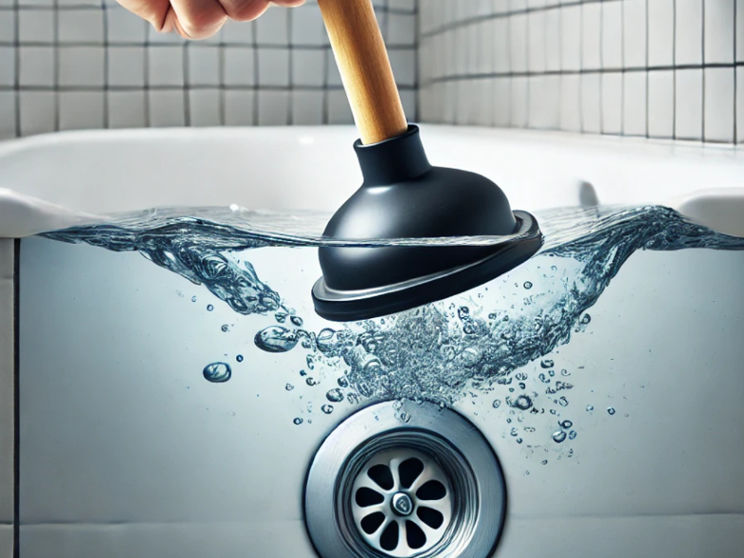You step into the bathtub, ready for a relaxing shower, only to notice water pooling around your feet. It’s frustrating, messy, and inconvenient. Why is my bathtub not draining? You’re not alone—this is a common issue faced by many homeowners. Thankfully, understanding the causes and solutions can make it easier to tackle. In this guide, we’ll explore what might be causing the problem, how to fix it, and steps to prevent it from happening again.
1. Common Causes of a Bathtub Not Draining
There are several reasons why your bathtub might not be draining properly. Let’s break down the most common criminals:
Hair and Soap Scum Clogs
Hair and soap collect over time in the pipe, filling up the drain. Hair tends to curl around other objects causing a blockage that slows the water. Visualize this: after a household member has their haircut, you notice the water draining much slower than usual. It’s most likely clumps of hair mixed with soap stuck just below the top.
Foreign Objects
Small items like toys, jewelry, or even bottle caps can accidentally fall into the drain. For instance, a child’s bath time might turn chaotic when a rubber duck or toy soldier finds its way down the drain, causing a complete blockage.
Mineral Buildup
If you live in an area with hard water, minerals can eventually build up within your pipes. The buildup does reduce the internal diameter of your pipes, meaning it slows your drainage down and eventually could stop. Think of your coffee machine’s pipe clogging after a while through calcium buildup.
Faulty Drain Stopper
A malfunctioning or improperly positioned drain stopper can also be the reason why your bathtub is not draining. When the stopper doesn’t open fully, it blocks water from flowing out efficiently.
2. How to Identify the Problem

Before jumping to solutions, it’s essential to figure out what’s causing the issue. Here’s how to diagnose the problem:
Visual Inspection
Shine a flashlight down the drain to look for something obvious such as hair or debris. If you see that the drain is clogged, it is probably the source of the backup.
Slow Draining Water
If the water is draining slowly, but not stuck, there may be a partial blockage in the drain. This is usually a sign of hair and soap scum.
Unpleasant Odors
A foul smell coming from your bathtub drain can signal a deeper issue, like decaying organic matter or a more stubborn clog.
3. DIY Fixes for a Bathtub Not Draining
Now that you’ve identified the problem, let’s look at some effective DIY fixes. These solutions are simple, cost-effective, and don’t require professional help.
Using a Plunger
A plunger is a close tool for minor clogs.
- Fill the bathtub with enough water to cover the plunger’s suction cup.
- Place the plunger over the drain and push down firmly, then pull up. Repeat the motion several times to dislodge the clog.
- Test the drain to see if the water flows properly.
Baking Soda and Vinegar Solution
This natural remedy works wonders for dissolving minor clogs:
- Pour 1/2 cup of baking soda into the drain, followed by 1/2 cup of vinegar.
- Let the mixture fizz for 15-20 minutes.
- Flush the drain with boiling water to clear the residue.
Removing the Drain Stopper
Sometimes, the issue lies with the stopper itself:
- Unscrew and remove the stopper.
- Clean it thoroughly to remove soap scum, hair, or debris.
- Reinstall it properly to ensure smooth operation.
Drain Snake or Wire Hanger
For deeper clogs, a drain snake or an unbent wire hanger can be helpful:
- Insert the tool into the drain and twist it to hook onto the clog.
- Pull the tool out slowly, removing the debris.
- Rinse the drain with water to ensure it’s clear.
4. When to Call a Professional

If none of the DIY methods work, it might be time to bring in a professional. Here are signs that the issue is more severe:
- Water is backing up into other fixtures, such as sinks or toilets.
- The bathtub remains clogged despite repeated attempts to fix it.
- There are structural problems with the plumbing system, such as damaged pipes.
Calling a plumber ensures the problem is resolved correctly without causing further damage.
5. Preventing Future Drainage Problems
Once you’ve resolved the issue, follow these tips to keep your bathtub draining smoothly:
Regular Cleaning
Remove hair and soap scum from the drain weekly. A little maintenance goes a long way in preventing clogs.
Use Drain Covers
Install a drain cover to catch hair, debris, and small objects. These affordable tools are easy to clean and highly effective.
Avoid Pouring Grease or Oil
Many people don’t realize that grease and oil solidify in pipes, leading to blockages. Always dispose of these substances in the trash, not the drain.
Flush with Hot Water
Periodically pour boiling water down the drain to dissolve any minor buildup of soap or grease.
Schedule Professional Maintenance
If your home is susceptible to drainage issues, consider hiring a plumber to inspect your pipes annually to identify potential problems.
6. FAQs About Why is My Bathtub Not Draining?
Q: How regularly should I clean my bathtub drain to prevent clogs?
A: It’s recommended to clean your drain weekly to remove hair and soap scum that can accumulate over time.
Q: Can I use a chemical drain to fix clogs?
A: While chemical soaps can be effective, they may harm your pipes over time. Opt for natural systems like baking soda and vinegar whenever possible.
Q: What should I do if water backs up into other fixtures?
A: This usually indicates a more significant plumbing issue. Contact a professional plumber to inspect your system.
Q: Is it safe to use hot water to clear clogs?
A: Boiling water is safe for most metal pipes, but it must be used with caution with PVC pipes so as not to damage them.
Q: How do I know if the clog is in the main drain line?
A: If your house has one or more slow or backed-up drains, it may be the main sewer line. Inspection by a professional is required.
Conclusion
So, why is my bathtub not draining? Well, understanding common causes of a non-draining bathtub- hair and soap scum clogs to faulty drain stoppers-is key. With an identified problem, DIY fixes, and some preventive measures, your bathtub should run just fine.
If your efforts don’t resolve the problem, don’t hesitate to seek professional help. A plumber can address more complex issues and ensure your plumbing stays in top condition.
Don’t let a clogged bathtub ruin your day—take action now to keep your drains clear and hassle-free.